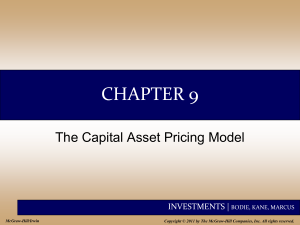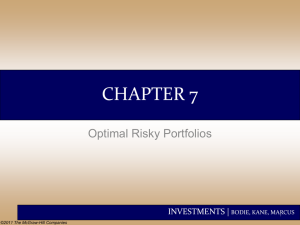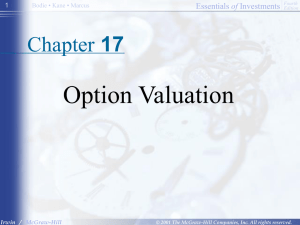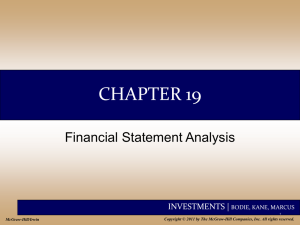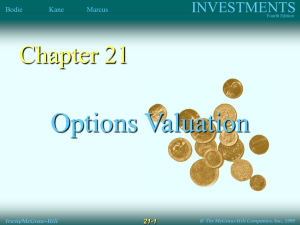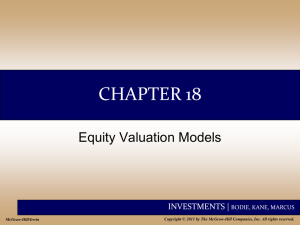Capital Allocation Line.
advertisement
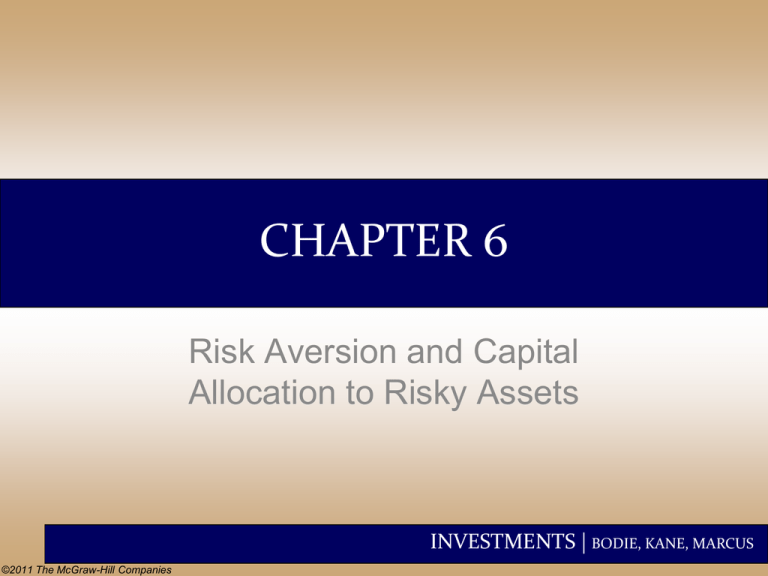
CHAPTER 6 Risk Aversion and Capital Allocation to Risky Assets INVESTMENTS | BODIE, KANE, MARCUS ©2011 The McGraw-Hill Companies Allocation to Risky Assets • Investors will avoid risk unless there is a reward. – i.e. Risk Premium should be positive • Agents preference (taste) gives the optimal allocation between a risky portfolio and a risk-free asset. INVESTMENTS | BODIE, KANE, MARCUS ©2011 The McGraw-Hill Companies Speculation vs. Gamble • Speculation – Taking considerable risk for a commensurate gain – Parties have heterogeneous expectations • Gamble – Bet or wager on an uncertain outcome for enjoyment – Parties assign the same probabilities to the possible outcomes INVESTMENTS | BODIE, KANE, MARCUS ©2011 The McGraw-Hill Companies Table 6.1 Available Risky Portfolios (Riskfree Rate = 5%) Each portfolio receives a utility score to assess the investor’s risk/return trade off INVESTMENTS | BODIE, KANE, MARCUS ©2011 The McGraw-Hill Companies Utility Function U = utility of portfolio with return r E ( r ) = expected return portfolio A = coefficient of risk aversion s2 = variance of returns of portfolio ½ = a scaling factor 1 2 U E (r ) As 2 INVESTMENTS | BODIE, KANE, MARCUS ©2011 The McGraw-Hill Companies Table 6.2 Utility Scores of Alternative Portfolios for Investors with Varying Degree of Risk Aversion IN CLASS EXERCISE. Anwer: How high the risk aversion coefficient (A) has to be so that L is preferred over M and H? INVESTMENTS | BODIE, KANE, MARCUS ©2011 The McGraw-Hill Companies Mean-Variance (M-V) Criterion • Portfolio A dominates portfolio B if: • And ErA ErB sA sB • As noted before: this does not determine the choice of one portfolio, but a whole set of efficient portfolios. INVESTMENTS | BODIE, KANE, MARCUS ©2011 The McGraw-Hill Companies Estimating Risk Aversion • Use questionnaires • Observe individuals’ decisions when confronted with risk • Observe how much people are willing to pay to avoid risk INVESTMENTS | BODIE, KANE, MARCUS ©2011 The McGraw-Hill Companies Capital Allocation Across Risky and RiskFree Portfolios Asset Allocation: • Is a very important part of portfolio construction. • Refers to the choice among broad asset classes. – % of total Investment in risky vs. risk-free assets Controlling Risk: • Simplest way: Manipulate the fraction of the portfolio invested in risk-free assets versus the portion invested in the risky assets INVESTMENTS | BODIE, KANE, MARCUS ©2011 The McGraw-Hill Companies Basic Asset Allocation Example Total Amount Invested Risk-free money market fund Total risk assets Equities $300,000 $90,000 Bonds (long-term) $96,600 $113,400 WE 0.54 $210,000 Proportion of Risk assets on Equities $210,000 $113,400 $96,600 WB 0.46 $210,00 Proportion of Risk assets on Bonds INVESTMENTS | BODIE, KANE, MARCUS ©2011 The McGraw-Hill Companies Basic Asset Allocation • P is the complete portfolio where we have y as the weight on the risky portfolio and (1-y) = weight of risk-free assets: $210,000 y 0.7 $300,000 1 y $113,400 E: .378 $300,000 $90,000 0.3 $300,000 $96,600 B: .322 $300,000 • Complete Portfolio is: (0.3, 0.378, 0.322) INVESTMENTS | BODIE, KANE, MARCUS ©2011 The McGraw-Hill Companies The Risk-Free Asset • Only the government can issue defaultfree bonds. – Risk-free in real terms only if price indexed and maturity equal to investor’s holding period. • T-bills viewed as “the” risk-free asset • Money market funds also considered risk-free in practice INVESTMENTS | BODIE, KANE, MARCUS ©2011 The McGraw-Hill Companies Figure 6.3 Spread Between 3-Month CD and T-bill Rates INVESTMENTS | BODIE, KANE, MARCUS ©2011 The McGraw-Hill Companies Portfolios of One Risky Asset and a RiskFree Asset • It’s possible to create a complete portfolio by splitting investment funds between safe and risky assets. – Let y=portion allocated to the risky portfolio, P – (1-y)=portion to be invested in risk-free asset, F. INVESTMENTS | BODIE, KANE, MARCUS ©2011 The McGraw-Hill Companies Example Using Chapter 6.4 Numbers rf = 7% srf = 0% E(rp) = 15% sp = 22% y = % in p (1-y) = % in rf INVESTMENTS | BODIE, KANE, MARCUS ©2011 The McGraw-Hill Companies Example (Ctd.) The expected return on the complete portfolio is the risk-free rate plus the weight of P times the risk premium of P E (rc ) rf y E (rP ) rf Erc 7 y15 7 INVESTMENTS | BODIE, KANE, MARCUS ©2011 The McGraw-Hill Companies Example (Ctd.) • The risk of the complete portfolio is the weight of P times the risk of P: s C ys P 22y – This follows straight from the formulas we saw before and the fact that any constant random variable has zero variance. INVESTMENTS | BODIE, KANE, MARCUS ©2011 The McGraw-Hill Companies Feasible (var, mean) • Taken together this determines the set of feasible (mean,variance) portfolio return: Erc 7 y15 7 s C ys P 22y – This determines a straight line, which we call Capital Allocation Line. Next we derive it’s equation completely INVESTMENTS | BODIE, KANE, MARCUS ©2011 The McGraw-Hill Companies Example (Ctd.) • Rearrange and substitute y=sC/sP: sC 8 E rC rf E rP rf 7 s C sP 22 – The sub-index C is to stand for complete portfolio Slope E rP rf sP 8 22 – The slope has a special name: Sharpe ratio. INVESTMENTS | BODIE, KANE, MARCUS ©2011 The McGraw-Hill Companies Figure 6.4 The Investment Opportunity Set INVESTMENTS | BODIE, KANE, MARCUS ©2011 The McGraw-Hill Companies Capital Allocation Line with Leverage • Lend at rf=7% and borrow at rf=9% – Lending range slope = 8/22 = 0.36 – Borrowing range slope = 6/22 = 0.27 • CAL kinks at P INVESTMENTS | BODIE, KANE, MARCUS ©2011 The McGraw-Hill Companies Figure 6.5 The Opportunity Set with Differential Borrowing and Lending Rates INVESTMENTS | BODIE, KANE, MARCUS ©2011 The McGraw-Hill Companies Risk Tolerance and Asset Allocation • The investor must choose one optimal portfolio, C, from the set of feasible choices – Expected return of the complete portfolio: E (rc ) rf y E (rP ) rf – Variance: s ys 2 C 2 2 P INVESTMENTS | BODIE, KANE, MARCUS ©2011 The McGraw-Hill Companies Table 6.4 Utility Levels for Various Positions in Risky Assets (y) for an Investor with Risk Aversion A = 4 INVESTMENTS | BODIE, KANE, MARCUS ©2011 The McGraw-Hill Companies Figure 6.6 Utility as a Function of Allocation to the Risky Asset, y INVESTMENTS | BODIE, KANE, MARCUS ©2011 The McGraw-Hill Companies Table 6.5 Spreadsheet Calculations of Indifference Curves INVESTMENTS | BODIE, KANE, MARCUS ©2011 The McGraw-Hill Companies Portfolio problem • Agent’s problem with one risky and one risk-free asset is thus: • Pick portfolio (y, 1-y) to maximize utility U – U(y,1-y) = E(r_C) -0.5*A*Var(r_C) • Where r_C is the complete portfolio – This is the same as – r_f + y[E(r) – r_f] -0.5*A*y^2*Var(r) – Solution (take foc) is y (proportion on risky asset) as (1/A)*SharpeRatio INVESTMENTS | BODIE, KANE, MARCUS ©2011 The McGraw-Hill Companies Figure 6.7 Indifference Curves for U = .05 and U = .09 with A = 2 and A = 4 INVESTMENTS | BODIE, KANE, MARCUS ©2011 The McGraw-Hill Companies Figure 6.8 Finding the Optimal Complete Portfolio Using Indifference Curves INVESTMENTS | BODIE, KANE, MARCUS ©2011 The McGraw-Hill Companies Table 6.6 Expected Returns on Four Indifference Curves and the CAL INVESTMENTS | BODIE, KANE, MARCUS ©2011 The McGraw-Hill Companies Risk Tolerance and Asset Allocation • The investor must choose one optimal portfolio, C, from the set of feasible choices – Expected return of the complete portfolio: E (rc ) rf y E (rP ) rf – Variance: s ys 2 C 2 2 P INVESTMENTS | BODIE, KANE, MARCUS ©2011 The McGraw-Hill Companies One word on Indifference Curves • If you see the IC curves over (mean,st. dev) you will note that these are all nice smooth concave curves. – This is an assumption. – Note that agents have preference over random variables (representing payoff/return). A random variable, in general, is not completely described by (mean, variance). • That is, in general, we can have X and Y with mean(X) < mean (Y) and var(X)=var(Y) BUT X is ranked better than Y nonetheless. – IF agents have expected utility, we can solve this issue in two ways. INVESTMENTS | BODIE, KANE, MARCUS ©2011 The McGraw-Hill Companies One word on Indifference Curves • First method is: • Assumption 1: all random variables are normally distributed • Assumption 2: agents have expected utility with Bernoulli given by u(x)= a*x^2 + bx + c – BLACKBOARD (Expected utility computation) INVESTMENTS | BODIE, KANE, MARCUS ©2011 The McGraw-Hill Companies Word on our Portfolio problem • So far we saw how to solver for INVESTMENTS | BODIE, KANE, MARCUS ©2011 The McGraw-Hill Companies Passive Strategies: The Capital Market Line • A natural candidate for a passively held risky asset would be a well-diversified portfolio of common stocks such as the S&P 500. • The capital market line (CML) is the capital allocation line formed from 1-month T-bills and a broad index of common stocks (e.g. the S&P 500). INVESTMENTS | BODIE, KANE, MARCUS ©2011 The McGraw-Hill Companies Passive Strategies: The Capital Market Line • The CML is given by a strategy that involves investment in two passive portfolios: 1. virtually risk-free short-term T-bills (or a money market fund) 2. a fund of common stocks that mimics a broad market index. INVESTMENTS | BODIE, KANE, MARCUS ©2011 The McGraw-Hill Companies Passive Strategies: The Capital Market Line • From 1926 to 2009, the passive risky portfolio offered an average risk premium of 7.9% with a standard deviation of 20.8%, resulting in a reward-to-volatility ratio of .38. INVESTMENTS | BODIE, KANE, MARCUS ©2011 The McGraw-Hill Companies

